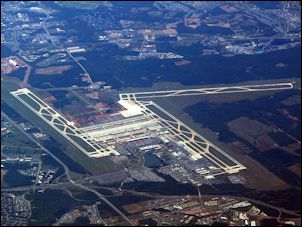by James A. Bacon
Washington-area media finally have woken up to the major problems gripping Washington Dulles International Airport. In an April article Michael Neibauer with the Washington Business Journal noted that this important “economic engine” of Northern Virginia is sputtering. The problem of declining domestic traffic, siphoned mainly to Reagan National Airport, is compounded by the reckless expansion of the airport last decade that left its balance sheet over-leveraged. The debt service is $240 million a year, or roughly $23 of the $25 cost per enplanement. As Neibauer wrote:
A major capital improvement program and, more generally, the high cost of managing international passengers, has driven the average “cost of enplanement” at Dulles to near $25. At Reagan, it is $14.
Airlines don’t want to shoulder that burden, so they cut back on seats, or flights, or opt not to fly there at all, driving passenger numbers down and cost per enplanement up, precipitously.
Of course, none of this is news to readers of Bacon’s Rebellion. More than a year-and-a-half ago — long before other media had discovered the story — Reed Fawell detailed the airport’s problems. His articles, “Dulles’ Grand Plan” and “A Mortgage on Northern Virginia’s Future” are still worth re-reading.
So, now that Metropolitan Washington Airports Authority (MWAA) management is finally facing up to its Dulles problems, what is it doing?
Lobbying. Dulles’ friends are seeking to restrict the continued expansion of capacity at National. (In other words, they’re conceding failure and Dulles’ inability to compete with Reagan.)
Subsidize. Through a new lease-and-use agreement, MWAA is transferring $300 million in revenue from National to Dulles over ten years. (Rob from Reagan to pay Dulles.)
Attract new carriers. New carriers include Frontier Airlines and Air China.(This is a positive response — competing harder adds economic value and forces Reagan and Baltimore-Washington Airport to up their game.)
Belt tightening. “We’ve tightened our belt,” said Jack Potter, CEO of MWAA. “We’re not spending money if we don’t have to spend it. We’re not investing in anything new.” (A little late in the game, but better late than never.)
Bacon’s bottom line: The good news is that MWAA management is dealing with reality instead of pursuing a fantasy. Although one can question the rent-seeking, I-win-you-lose approach to fixing Dulles’ problems, the airport’s clamp-down on costs and hustling for new airlines are positive signs.
But I’m wondering if anyone else has learned the lesson. Dulles overbuilt in the early-mid 2000s because it extrapolated the extraordinary traffic growth of Northern Virginia’s post-9/11 boom indefinitely into the future. When that growth did not materialize, Dulles was left sucking wind. Northern Virginia’s commercial real estate sector was the next to learn that its growth forecasts not only were excessively optimistic overall but wrong as to where growth would occur within the metropolitan region. The result: many suburban office parks on the metropolitan fringe are faring even worse than Dulles.
What other growth forecasts based on outdated, 10-year-old numbers are underpinning investment decisions in Northern Virginia? Could the Virginia Department of Transportation be relying upon outdated numbers to justify its $2.1 billion capital spending program for Interstate 66? Numbers used for planning purposes tend to get updated at a glacial pace — once embedded in the system, the assumptions behind the numbers stay in place for years. That’s fine when the system is stable but potentially disastrous if the numbers fail to reflect a dramatic inflection point like that which occurred in the 2007-2008 recession.
Bacon’s Rebellion and friends will be giving the numbers a closer look.



